Power Supply Design for 5v Using 7805 Pdf
Here are the 7805 datasheet of popular 5V voltage regulator IC and the 7805 pinouts.
They are designed to provide a constant 5V. When powered by from about 7.3 to 35 volts.
We usually want to use a stable voltage source. Which it is a lower voltage than batteries.
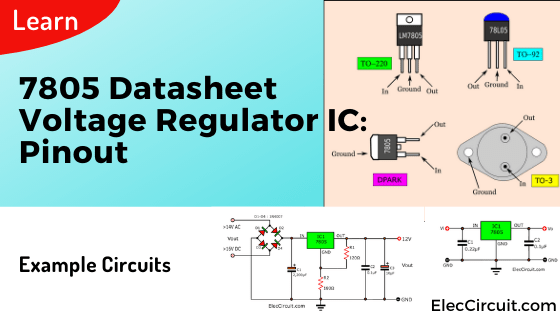
Sometimes, the transformer power supply may have a high voltage. Thus it can help you.
The 7805 is a good device to power the TTL family of digital integrated circuits.
It is ideal for any circuit that requires a very stable 5V power supply.
7805 Pinout and Specifications

Inside IC-7805 has many components are connected into a Schematic diagram.
It is so a lot! So, In general use, We do not need to understand those devices.
We just use it by understanding its features and limitations.
Look:
7805 datasheet internal circuit

Compare with the simplest Zener diode and transistor regulator circuit.
Input voltage: 12V and Output: 5V 1A. as well.
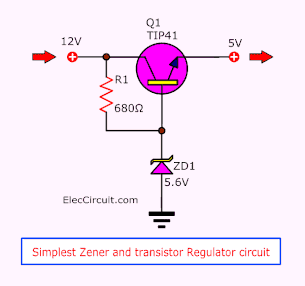
But after has a few parts than the IC version. Just only power transistor Zener diode 5.6V and one Resistor.
Basic 78xx regulator circuit
Look at the basic circuit diagram using a 78xx regulator. In 7805 datasheet said C1 and C2 will keep the stability of the circuit. To reduce any noise, spike voltage, and more.
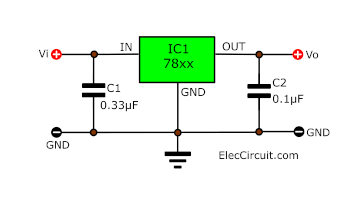
Basic 78xx Regulator circuit diagram
Actually, I have tried without the capacitors or only one IC. The circuit works normally.
Which is better? Which do you choose?
7805 Datasheet
Basic Feature
- Typical output voltage: A typical 7805 delivers 5V. Some model may provide from 4.8V to 5.2V.
- Load regulation: The load is typically regulated to within 10mV and less than 50mV.
- Peak output current: The TO220 version of 7805 delivers more than 1A to a load. But, its aluminum heatsink mounts to an appropriate heatsink.
- Internal overload protection: If the 7805 regulator IC operates over too much and starts to overheat. A special thermal overload circuit will automatically turn off the chip until the temperature returns to a safe level.
- The minimum input voltage to deliver 5 volts output: 7.3V. below 7.3V the chip may not provide a stable 5 volts.
- The operating current (IQ) is 5mA.
- Internal Thermal Overload and Short circuit current limiting protection are available.
- Junction Temperature maximum 125 degrees Celsius.
- Available in TO-220 and KTE package.
- Maximum input voltage: 30VDC, but higher voltage it needs to hold current and more power on it. So, it is too hot.
So, for some questions: How 24V to 5V using the 7805 circuits? or What regulator IC converts a 24v to 5v? You will get here.
Then, see
7805 Pinout Be careful!
Other 7805 versions: The 7805 has various versions. The TO-3 version comes in an all-metal can for better heat sinking. A small plastic TO-92 version provides up to 100 mA for low power circuits.
In the present, we will often see DPARK, since It is a small size suitable for SMD PCB work.

Look at 2 popular types of regulator IC. Both differ only in the current output:
- The 7805. (TO-220) This is a 5v, 1A device. I like it. Because it can supply high current, easy installation and cheap.
- The 78L05. (TO-92) This is a 5V, 100mA device that looks like a small transistor.
This voltage regulator IC can deliver a fixed or adjustable voltage from an external power source.
You should bolt the 7805 regulators to a metal heat sink using the hole at the top.

Thanks: Photo L7805 Buy now
3 Important for 7805
There are 3 main keys, you should know about 7805 for smooth operation.
- Close wiring—Connects capacitors across the regulator to remove oscillations.
- Enough heatsink—You can hold your finger on it for at least 30 seconds or so.
- Least 5V input—The input voltage must be more than 5V of the output. Because diode bridges have 1.5V across them. Then, the regulator is at least 3.5v across it (To Keeping regulation).
Read below to get this:
Typical Applications
I love a lot of circuits.
They help me grow in Electronics, and you?
You can use it in many ways.
Fixed Output Regulator
Look at the 5V fixed output regulator.
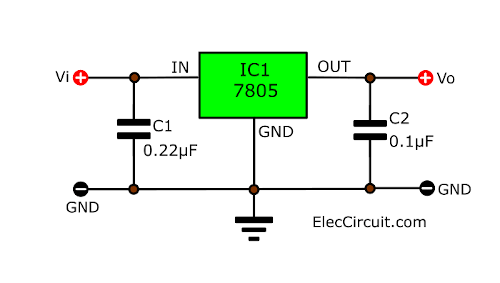
It is easy, right?
Remember:
You should use bypass capacitors (C1 and C2) for optimum stability and transient response and put it close as possible to the IC.
See typical 7805 power supply
The C1-2200uF and C2 0.1uF capacitor must be mounted close to the regulator.
The input voltage must be higher than the output to allow for the voltage drop across the bridge and regulator.
The minimum for a 5v output is 7V AC or 9V DC.
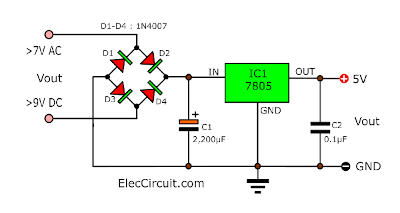
Note: Any connecting to input AC or DC to the bridge. It will automatically adjust for correct polarity. Is it good? It allows an either-way connection to power the board.
The diagram below shows a 7805 regulator circuit built on breadboard.
This open-type arrangement is only suitable for a very low output current as the 7805 is not heatsinked. It needs to have short leads between the output a 0.1uF capacitor to prevent it from oscillating internally.
Power Supply 5V 0.5A using IC 7805
Look at the circuit below. If you have only two diodes full-wave rectifier and transformer center tap. This may be a great choice for you.
Also it is 5V 0.5A Fixed Voltage regulator circuit using 7805.
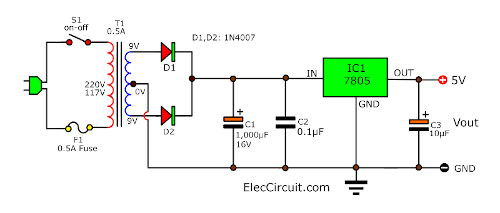
For working principle
I would permit to tell simply. When the home electric source ACV, 110V or 230V or a 220V, depending on your country, through the transformer, the voltage remains 9VAC.
Then through the diode for rectifier power supply to the DCVolt, And a filter circuit with Capacitors.
This is a voltage is about 12VDC. It does not work through IC-7805, before our hero.
Read other website: 7805 Datasheet I like see you improve in electronics:
To control a stable 5V voltage which can prevent also a short circuit.
Just now I have a small circuit great ready to use it.
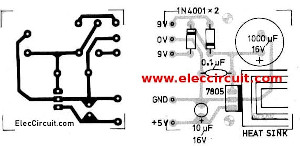
The PCB layout of Power Supply 5V 1A by IC 7805 and The all components layout.
Increasing The output Voltage
That's not all…
Imagine you want the 12V power supply. But you have only 7805. How do you do?
Colin Mitchell said the output voltage of a supply can be increased by "jacking up".
The circuit below produces an output of 12V.
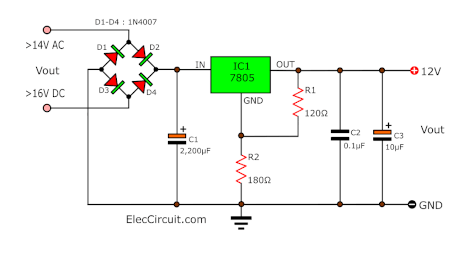
The 7805 runs: It alway keeps a voltage of 5V, between output and GND (common) terminal.
If the common voltage increases, the output voltage will be 5V higher.
This method can give almost any voltage between 5V and 30V
It is complete range of regulators.
We use two resistors in VOLTAGE DIVIDER MODE to determine the output voltage.
There is 5 volts always across the R1-120 ohms resistor.
And, if another resistor is placed in series, it will have a proportional voltage across it.
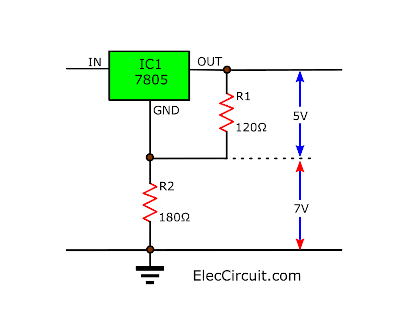
In the basic circuit diagram, At R2 – 180 ohms has across it is 7V. Then it makes a total of 12v on the output.
To increase or decrease the voltage, only one resistor has to be changed in the circuit above. We use the R1-120 ohms is retained and the R2-180 ohms resistor is changed.
If it is increased to R2-Resistors:
- 220 ohms resistors, the output voltage will be 14V.
- 330 ohms, the output voltage will be 18V.
This will produce an adjustable output voltage.
There is only one problem with an adjustable supply.
The 7805 regulators must be heatsinked so it is capable of dissipating the heat for the worst condition.
In addition, the input voltage must be sufficient to cater to the maximum output voltage.
7805 voltage regulator formula
The following formula is used when 5V is the nominal output voltage (output to common) of the fixed regulator
Vout = 5V + (5V/R1 + IQ)R2
For example:
R1=120, R2= 180
IQ = 5mA(0.005A)
Vout = 5V +(5V/120 + 0.005) 180
= 13.4V
Then I test it on the breadboard. They have similar values. (13.2V) So we can use this formula.
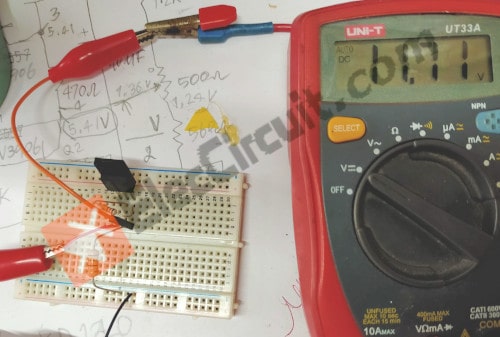
You see a problem with the method, right?
Sometimes we can't find a resistor that has a similar value. It causes the output voltage to move from the desired value. So we better replace R2 with a potentiometer.
How to change 7805 voltage using diode
This is increasing an output voltage 78xx using a diode. The 78xx series are very cheap, popular. Although It is a fixed voltage regulator, we can change the output voltage level with many how.
A diode is a normal component in many stores, such as 1N4148 Diode. They have High efficiency and suitable for general uses.
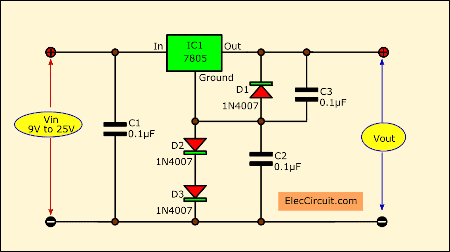
Circuit diagram of increasing output voltage 7805 using the diode
While the electric current is flowing a diode in forward-bias. It has a voltage across that is very accurate, about 0.65V in each diode.
In the circuit above…
See more: 6V power supply circuit diagram
We add a diode Both diodes D2, D3 – 1N4148 in series, at between a common leg of IC1 and Ground. The output voltage will rise to about 0.65V + 0.65V = 1.3V every diode.
Suppose…
We use an LM7809 having the output voltage of 9V. Thus, the output of this circuit is 1.3V + 9V = 10.3 V.
Then, if we add another diode into 3 diodes. The voltage drop across on them of 1.3V + 0.65V = 1.95V.
So the output is 9V + 1.95 = 10.95V
We add a diode D1 to protect the regulator damaged of the output. It may have a feedback voltage come back from a load. The D1 is connecting in the reverse bias, it will absorb current spike to protects this circuit.
Next, we add 2 capacitors C1, C3 to filter out the transient noise. Which it can be induced into the supply by stray magnetic fields.
In addition, adding a capacitor-C2 drop across both diodes to improve a stability regulation. It will reduce noise at the output.
Adjustable output voltage
We can adjust the output voltage from 5V to 24V via the R2-potentiometer connected to the GND.
Look:
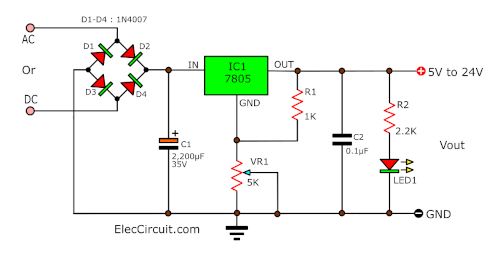
The input voltage and heatsinking of the regulator must be sufficient for the output voltage and current.
If the input voltage is 24V – 36v. The output may not deliver more than 100mA @ 5V. Because of the heat produced by the regulator.
Recommended:
- 7805 Adjustable voltage regulator circuit with PCB
- 5V to 25V Dual Adjustable voltage regulator using 7805 & 7905
High input voltage circuits
We know that cannot use 7805 with a higher than 30V input voltage. But these may good ideas to do.
Look at below.
First, use a limiting current resistor. It is easy and cheap. But it will reduce current down. So, it is suitable for a low current of the load.
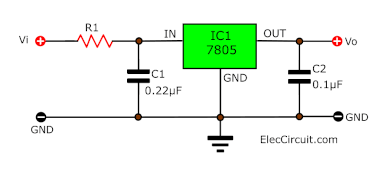
Second, with helping of the transistor and Zener diode. this makes it more current up. And the output is steady, too.
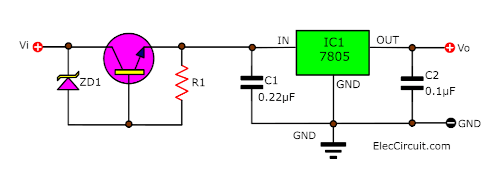
The Diode Protection
Although this IC number has a very good protection system. But Reverse polarity can damage it. So we should put a protective diode.
Output Polarity-Reversal-Protection Circuit
In many cases, a regulator powers a load that is not connected to the ground. But it is connected to a voltage source of opposite polarity (e.g., operational amplifiers, level-shifting circuits, etc.) instead.
We should connect a clamp diode to the regulator output, see below.
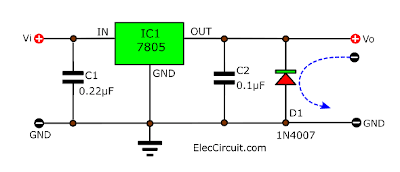
This protects the regulator from output polarity reversals during startup and in short-circuits operations, too.
Reverse-bias protection
Sometimes, the input voltage to the regulator can collapse faster than the output voltage.
This can occur. For example, when the input supply is crowbarred during an output overvoltage condition.
If the output voltage is greater than approximately 7V. The emitter-base junction of the series-pass element (internal or external) may break down and be damaged.
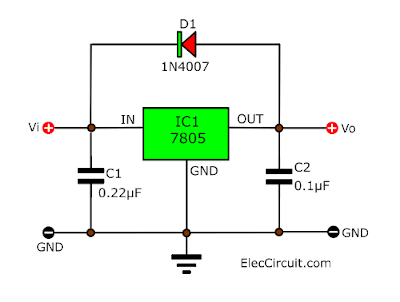
Use a diode shunt to prevent this, see in the circuit.
High Current Voltage Regulator
If you require more than 1A. Combine 7805 with other components to provide an output of up to 3A. See the circuit below.
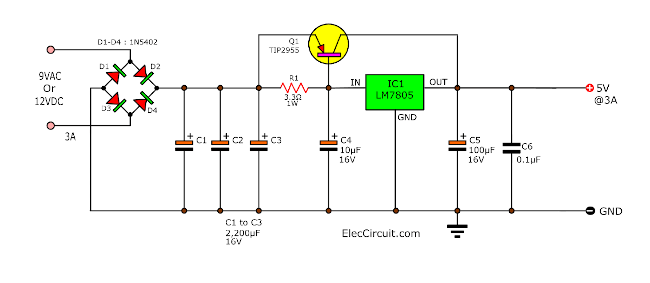
The TIP2955 switches the high current by itself. So, the 7805 can run without a heatsink. It only regulates the voltage.
Note:
- Use the 3A diodes (1N5402) in the power supply. For currents greater than 3A.
- Use 3 x 2,200uF electrolytic capacitor in parallel. They have more capacitance are 6,600uF for 3A current filter.
- Add TIP 2955 transistors in parallel on top of the TIP in the circuit. If the gain of each transistor is approximately the same, the transistors will current-share the load and get equally hot.
3A Regulated Power supply with short circuit protection
In the previous circuit, when short circuit the TIP2955 runs with high current. It is too hot. And finally, it may be damaged.
Easiest, we protected it with a normal fuse.
We use a 3A fuse. When the current exceeds 3A, the fuse blows immediately, is it easy? But if the fuse blows frequently, we are inconvenient.
Second, use other PNP transistor (Q2) to check error current.
Look at the circuit.
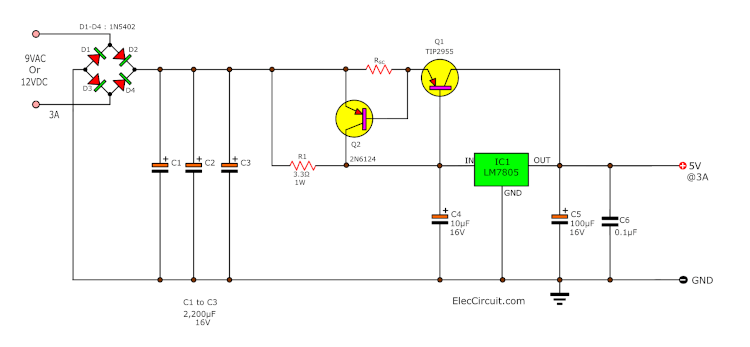
You can find R1, RSC and read more here:
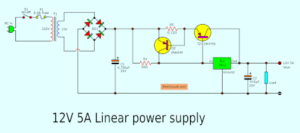
Design: 12V 5A Power supply using 7805
Although it uses 7812, but I believe You can use it for sure.
Positive and Negative regulator
Sometimes, we need a +5V and -5V Dual power supply for Op-amp circuits or others. You can use 7805 for making this circuit below.
Designers want economical and cost-effective. This will load 1.5A output(min).
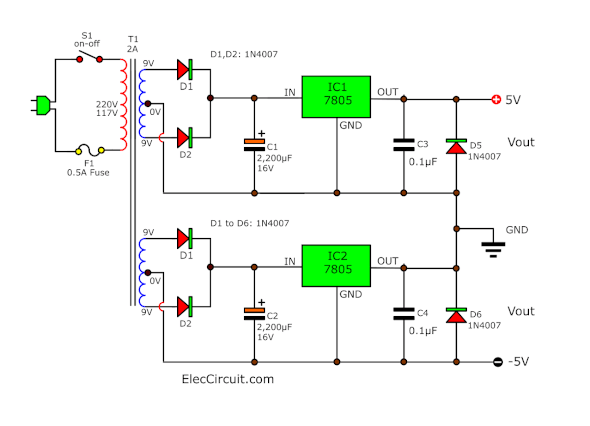
Note:
This circuit requires a 9V CT 9V at 2A transformer only for the full current of 1A load.
If you not have this transformer! Read below
Recommended Dual power supply:
- 7805-7905 Dual Adjustable power supply
- 30V Dual output using LM317 and LM337
Current Regulator using uA7805
Imagine you want to charge a battery with constant current and fixed voltage. You have many ways to do.
Now I will show you use uA7805 as the current regulator circuit. It is easy and cheap, too.
Look at the basic circuit below.
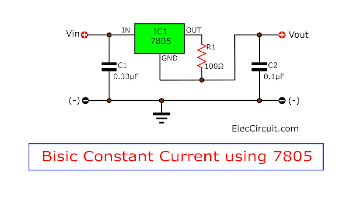
You can easily set output current with R1-resistor. And Here is formula to find it.
IO = (VO/R1) + IO Bias Current
Note:
IQ (bias current) = 5mA
What is more? I know you like this circuit.
Let's learn more: 7805 Constant current charger

Download This
All full-size images of THIS POST as PDF in the Ebook. Thanks, support me. 🙂
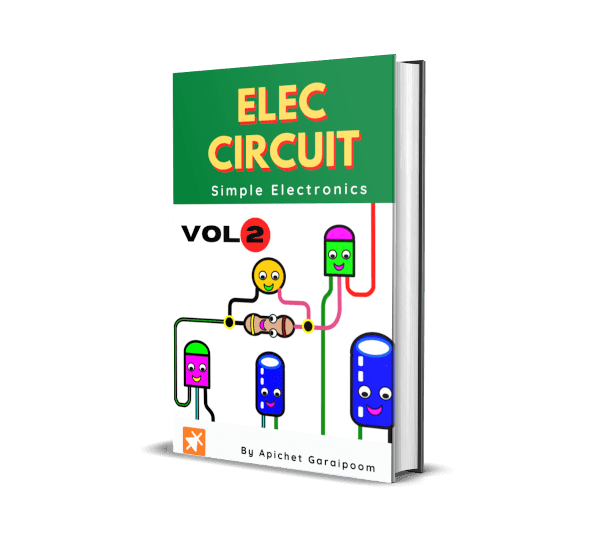
And more…
- Variable Regulator using 7805 and OP-AMP
- 5V 5A, 8A Power supply circuits
- 12V to 5V Step-Down Converter
- Fixed Voltage regulator using 78xx
Related Posts
GET UPDATE VIA EMAIL
I always try to make Electronics Learning Easy .
Power Supply Design for 5v Using 7805 Pdf
Source: https://www.eleccircuit.com/7805-5v-voltage-regulator-datasheet/
0 Response to "Power Supply Design for 5v Using 7805 Pdf"
Enregistrer un commentaire